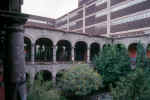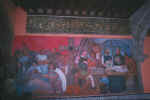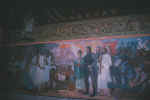Gallery of possible images for website
Click on these thumbnails to see them full size, use your browser's Back button to return.
For the moment these images are in no particular order. I am just scanning a few things quickly to post here to share among our working group. I would appreciate it if we could keep this address among ourselves while the work is in progress. If all works well, this may be a convenient place to post things as we work on building the actual site at another address.
 Hans Zinsser
Hans Zinsser
 Henry Rose Carter
Henry Rose Carter
These two images from the Library of Congress collection
 Charles Jules Nicolle from http://www.leplaisirdesdieux.com/LePlaisirDesDieux/AAIHP/InternatDeParis/idp20.nicolle.htm
Charles Jules Nicolle from http://www.leplaisirdesdieux.com/LePlaisirDesDieux/AAIHP/InternatDeParis/idp20.nicolle.htm
©NOTICE:
All images presented below are property of James B. Kiracofe and the Inter-American Institute and are protected by copyright law. These images may not be copied by any means for any purpose without written permission of the copyright owners.
Hospital de Jesús,
Mexico City
The Hospital de Jesús was built beginning in 1535 under the patronage of Hernan Cortés, who left additional money in his will for the continuation of the work, which progressed slowly, according to George Kubler ( Kubler, George. Mexican Architecture of the Sixteenth Century, New Haven: Yale University Press, 1948, p. 222). Kubler states that "in 1578 ten Indians and twelve masons were regularly assigned to the work." Seen here are modern frescoes painted beneath an original sixtgeenth-century frieze. The modern paintings depict scenes from the conquest era including an individual stricken with illness being cared for by others.
The Royal Hospital, another early hospital, was under construction in 1556 and by 1583 was considered the finest hospital in the city. In both of these hospitals revenue was derived from theatrical performances held within the courtyard. The Royal Hospital probably resembled the Hospital de Jesús seen above.
This is a photo of the town of Teposcolula in the Mixteca Alta of Oaxaca,
Mexico. The large building in the background is the Dominican Convento complex
with its spectacular open chapel on the left. This was used for open air
religious services and related activities. The rib-vaulted dome over the central
portion of the Open Chapel collapsed due to earthquakes and neglect. Work on the
complex began sometime after 1530, with the major work accomplished after 1555.
But as elsewhere all over Mexico, work here came to a halt as a direct result of
the epidemic of 1576-78. The residential portion of the complex was never
completed, and the nave of the conventual church (to the right of the open air
chapel) was roofed with the saucer domes in the 18th century. It seems the
facade may also have been reworked at that time, but incorporating elements of
earlier building campaigns.
Diego Rivera Propaganda Paintings in the National Palace
These paintings were executed by Diego Rivera after the Mexican Revolution and Civil War that lasted from 1910 until 1924. Rivera created a vision of Mexico that effectively communicated the new, revolutionary, national identity to a largely illiterate public. Rivera was an active member of the Communist party during most of his adult life, even hosting Leon Trotsky when he came to Mexico as an exile. Rivera's wife, Frieda Kahlo, had a notorious affair with Trotsky. Even though Rivera was a well known and politically active Communist, he lived in great luxury, painting for the rich and famous when government contracts and commissions from big capitalist corporations ran out. Rivera's work has done much to shape the modern Mexican self image. Nevertheless, the images he painted on the walls of the National Palace, very much in the public domain, are powerful works of art that portray the great Aztec capital with some accuracy.
Diorama in the Museum of Anthropology
This model shows how the temple complex at the center of the city may have looked, based on archaeology and eyewitness accounts. I do not know if this would be considered in the public domain, but I certainly own the copyright to my image of it...
I think the one on the right may be in the Templo Mayor Museum, I have to check it.
Sacrificial Knives at the Templo Mayor Museum.
These last two images are from the Templo Mayor Museum, showing sacrificial knives and a skull with a knife through it.
Jaguar Knight from Ixmiquilpan Murals
This painting is from the walls of the church at Ixmiquilpan, near the Chichimec frontier where the Mixton war was waged in the early 1540's. In this war uncivilized desert nomads raided the settled areas south of the Chichimec frontier. The Christian Indians of Ixmiquilpan defended their homes and new way of life alongside the Spanish against the nomad raiders. The Indians of Ixmiquilpan wished to commemorate their valor in these extremely unusual and fabulous paintings. There is some published work on these murals which I have in my files in Charlottesville. This is but one image of many I have of this set of paintings. These might be an important element in our site illustrating the direction cultural evolution was heading before the epidemcis.
Mural at Santa Maria Xoxoteco,
Hidalgo, Mexico
This mural painting from the fabulous chapel at Santa Maria Xoxoteco shows an Indian walking with a Spaniard in front of a Pre-Columbian style temple pyramid. This was painted circa 1550-1570 (as I recall, I have a book on this chapel in my library in Charlottesville, will have to check what is known about it). This painting was surely done by an Indian, who may have been a Tlacuilo in pre-columbian times. The Tlacuilos were the scribes who wrote using the pictographic writing system of official documents. Many were debriefed and trained by the Franciscans and others to serve as scribes writing now with Spanish letters in both Spanish and Nahuatl (and in some of the other native languages such as Mixtec and Chocho, though few of these documents survive) I have a number of similar images of painting done early in the colonial era where the two cultures were still blending.
Views of the Valley in Pre-Industrial times
These are photos I took of paintings in the National Gallery in Mexico City. They were painted in the 19th century, after the lakes had begun to dissappear, but they still give an idea of what the Valley of Mexico and the Valley of Puebla would have looked like in the 16th century. I do not have the identity of the artists, but I can look them up.


